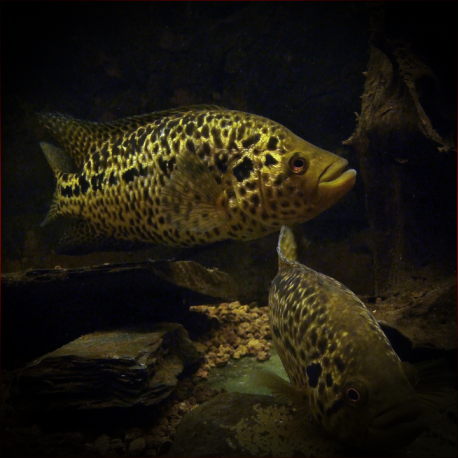More info
Datasheet
| Minimum Tank Size | 212 litres / 56.00 US gallons |
| Maximum Size | 50.8cm / 20.00inches |
| Temperature | 23°C / 73.40°F - 25°C / 77.00°F |
| Hardness | 6-18ºdH |
| pH | 6.0-8.0 |
General DescriptionParachromis Managuense, commonly known as the Jaguar Cichlid, is a large predatory cichlid native to North and Central America. These striking fish require spacious aquariums due to their size and predatory nature. Deciding on tankmates carefully, especially when breeding, is crucial due to their aggressive behavior towards smaller fish and territorial tendencies.
Aquarium SetupTo create an ideal environment for Parachromis Managuense, set up the aquarium with natural territory boundaries using rocks, wood, and caves to provide hiding spots for the female. The recommended tank size is a minimum of 212 litres, with water conditions that include a hardness of 6-18°dH, a pH range of 6.0-8.0, and a temperature between 23-25°C.
BehaviourThese cichlids often exhibit "Big cichlid syndrome," viewing smaller fish as food and displaying aggression, especially during breeding periods. Males can be territorial and aggressive towards females that do not want to breed when the male does. Adequate tank cover can help mitigate aggression and provide spaces for fish to establish their territories.
Feeding and DietParachromis Managuense are primarily carnivorous, feeding on smaller fish and aquatic invertebrates in the wild. In a home aquarium setting, offer a diet that replicates their natural preferences with high-quality carnivorous foods to ensure their nutritional needs are met.
Reproduction & DimorphismBreeding Parachromis Managuense involves the pair selecting a spawning site where eggs are laid and later moved to spawning pits. The parents diligently care for the fry for up to 6 weeks before potentially spawning again. Sexual dimorphism is evident, with females being smaller and rounder, while males possess pointed dorsal and anal fins and more vibrant coloring.
Habitat and DistributionIn the wild, Parachromis Managuense inhabit various biotopes ranging from murky lakes with soft substrates to clear streams and ponds. Their natural range extends from Honduras to Costa Rica in Central America, with introductions into other Central American countries, as well as Hawaii, the USA, Philippines, and Singapore.

